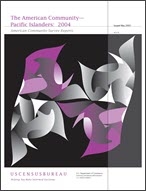The American Community—Pacific Islanders: 2004
The American Community—Pacific Islanders: 2004
Introduction
This report presents a portrait of the Native Hawaiian and Other Pacific Islander population in the United States.1 It is part of the American Community Survey (ACS) report series. Information on demographic, social, economic, and housing characteristics in the tables and figures is based on data from the 2004 ACS Selected Population Profiles and Detailed Tables.2 The data for the Pacific Islander population are based on responses to the 2004 ACS question on race, which asked all respondents to report one or more races.3
The 2004 ACS estimated the number of Pacific Islanders to be about 743,000, or 0.26 percent of the U.S. household population (Table 1).4 The number of individuals who reported Pacific Islander as their only race was about 404,000, or 0.14 percent of the population. About another 339,000 reported their race as Pacific Islander and one or more other races. The Pacific Islander-alone-or-in-combination population included about 90,000 Hispanics, and the Pacific Islander-alone population included about 39,000 Hispanics.5
Data are reported for both the Pacific Islander-alone and the Pacific Islander-alone-or-in-combination populations. In this report, respondents who reported Pacific Islander and no other race are included in the single-race or Pacific Islander-alone population (i.e., including those who reported their race as one or more detailed Pacific Islander groups but no non-Pacific Islander race). Respondents who reported Pacific Islander either alone or with one or more other race categories are included in the Pacific Islander-alone-or-in-combination population. The report also includes data for the non-Hispanic segments of these populations.
The term “Pacific Islander” is used to refer to the Native Hawaiian and Other Pacific Islander-alone population and the term “non-Hispanic White” is used to refer to the White-alone, not Hispanic population. Similarly, references to population groups such as Samoan refer to the single-race or “alone” segments of those populations.
The Pacific Islander population is not homogeneous; it includes many groups that differ in language and culture, and they primarily represent people of Polynesian, Micronesian, and Melanesian backgrounds. People who reported one or more Pacific Islander groups on the ACS question on race, such as Samoan or Tongan, are included as Pacific Islanders.
Polynesians numbered about 260,000 and include Native Hawaiians, Samoans, Tongans, and other Polynesian groups (Table 2). Micronesians numbered about 100,000 and include primarily Guamanians or Chamorros and other Micronesian groups such as Mariana Islanders, Marshall Islanders, and Palauans. Melanesians numbered about 23,000 and are predominantly Fijian and include other Melanesian groups such as Papua New Guineans.
Native Hawaiians were the largest Pacific Islander group, with a population of 155,000 or 38 percent of the Pacific Islander-alone population. Guamanians or Chamorros, with a population of 68,000, represented about 17 percent of the Pacific Islander-alone population. Samoans, with a population of 61,000, represented about 15 percent of the Pacific Islander-alone population.6 These three groups—Native Hawaiians, Guamanians or Chamorros, and Samoans—accounted for about 70 percent of the Pacific Islander population. In the future, as the ACS goes to full implementation and multiple-year estimates are produced, more information about additional groups may be available.
__________
1 In the federal government, the category “Native Hawaiian or Other Pacific Islander” refers to people having origins in any of the original peoples of the Pacific Islands (for example, Hawaii, Guam, Samoa, or Tonga). It includes people who indicated their race or races as “Native Hawaiian,” “Guamanian or Chamorro,” “Samoan,” or “Other Pacific Islander,” or wrote in entries such as Tahitian, Mariana Islander, or Chuukese.
2 The 2004 ACS datasets, including Selected Population Profiles and Detailed Tables, are available online in the American FactFinder at <factfinder.census.gov>.
3 For further information on the content and format of the questionnaire, see <www.census.gov/programs-surveys/acs/methodology/questionnaire-archive.2003-2004.html>.
4 This report discusses data for the United States, including the 50 states and the District of Columbia; it does not include data for Puerto Rico.
5 The estimates in this report are based on responses from a sample of households. Estimates may vary from the actual values because of sampling error and other factors. All comparative statements have undergone statistical testing and are significant at the 90-percent confidence level unless otherwise noted.
6 There is no statistical difference between the percentages of Guamanians or Chamorros and Samoans in the total Pacific Islander-alone population.
Related Information
Others in Series
Publication
Publication
Publication




